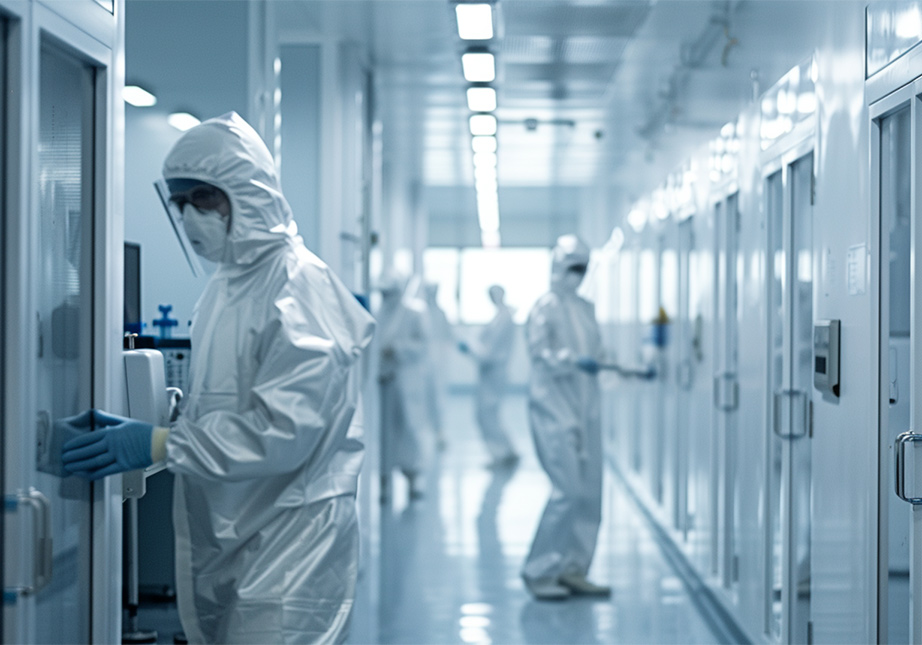
Jun 01, 2024
Medical Device Manufacturing Cleanrooms
Understanding Cleanrooms in Medical Device Manufacturing
Cleanrooms are specialized environments with controlled levels of pollutants such as dust, airborne microbes, and aerosol particles. In the context of medical device manufacturing, cleanrooms are defined by their adherence to specific ISO classifications, which dictate the cleanliness level based on the number of particles allowed per cubic meter at a specified particle size.
The Role of Cleanrooms in Medical Device Production
Cleanrooms are essential for the production of medical devices because they provide a controlled environment that minimizes the risk of contamination. This is particularly critical for devices that come into direct contact with human tissues, where any contamination could lead to serious infections or other medical complications.
Ensuring Safety and Efficacy
By maintaining stringent environmental controls, cleanrooms ensure that every medical device produced meets the highest standards of safety and efficacy. This is achieved through rigorous air filtration systems, such as HEPA filters, which remove particles from the air, and strict protocols that govern personnel behavior and material handling within the cleanroom.
Impact on Quality
The quality of medical devices is directly impacted by the conditions in which they are produced. Cleanrooms provide an environment where the risk of biocontamination is significantly reduced, which in turn enhances the reliability and performance of the medical devices manufactured within them. This not only meets the regulatory requirements but also builds trust with healthcare providers and patients who rely on the safety of these devices.
By integrating advanced technologies and equipment, such as automation and robotics, we at G-Con continuously strive to improve the standards of our cleanroom solutions, ensuring that your medical device manufacturing processes are at the forefront of quality and innovation.
ISO Classifications and Regulatory Standards
Understanding the ISO classifications and regulatory standards is crucial for cleanroom design and operation in medical device manufacturing. ISO 14644-1 standards specify the air cleanliness by particle concentration, which is pivotal for classifying a cleanroom. This classification ranges from ISO Class 1, the cleanest, to ISO Class 9, which allows a higher level of particulates.
Impact on Cleanroom Design and Operation
The ISO classification of a cleanroom dictates its design, including the choice of materials, the airflow systems, and the layout. For instance, an ISO Class 5 cleanroom will have stringent requirements for air changes and filtration compared to an ISO Class 8. These classifications directly influence the operational protocols, such as frequency of cleaning and the type of activities permitted within the space.
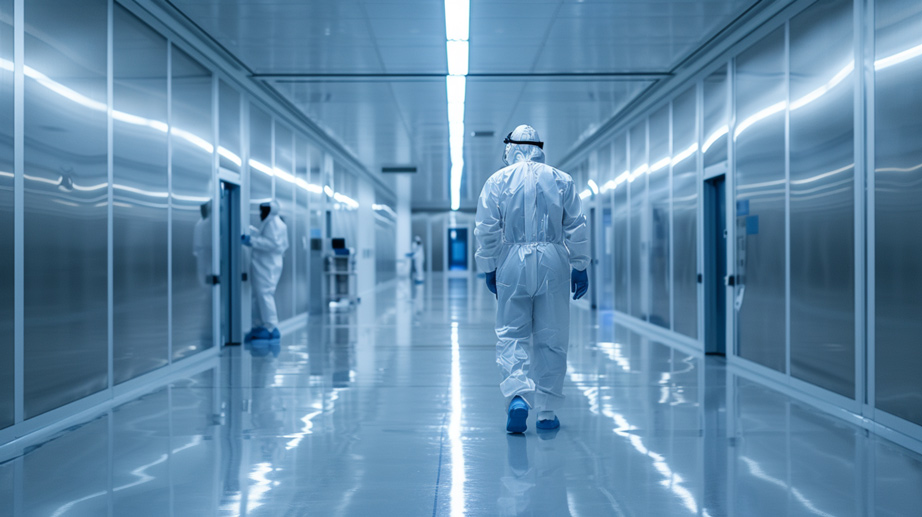
Compliance with Regulatory Standards
Cleanrooms must comply with regulatory standards to ensure product safety and efficacy. The FDA’s 21 CFR 211.42 outlines the requirements for the design and construction of cleanrooms used in drug manufacturing, which are also applicable to medical device production. Compliance with these regulations is non-negotiable for legal operation and market release of medical devices.
Influence on Maintenance and Monitoring
ISO classifications and regulatory standards necessitate rigorous maintenance and monitoring routines. Regular validation and certification are required to demonstrate ongoing compliance. This includes particle counting, microbial monitoring, and other environmental tests that are critical for maintaining the integrity of the cleanroom and the safety of the medical devices produced within.
At G-Con, we understand the importance of these standards and offer solutions that ensure our cleanrooms meet the stringent requirements necessary for your medical device manufacturing needs.
Key Considerations in Cleanroom Design
When designing a cleanroom for medical device manufacturing, several critical factors must be considered to ensure compliance with industry standards and optimal operational efficiency. The design must align with the goals of the cleanroom, such as the specific type of medical device being manufactured, and adhere to the required ISO classification standards.
Cleanroom Layout and Effectiveness
The layout of a cleanroom is instrumental in its effectiveness. It should facilitate a logical flow of materials and personnel to minimize the risk of contamination. The layout must also accommodate the necessary equipment and provide adequate space for critical processes, all while maintaining the integrity of the controlled environment.
Role of Air Filtration in Cleanroom Design
Air filtration is a cornerstone of cleanroom design. High-Efficiency Particulate Air (HEPA) filters are typically employed to remove particles from the air to meet the stringent ISO class requirements. The air filtration system must be designed to provide uniform airflow and maintain the necessary air changes per hour (ACH) to ensure a contaminant-free environment.
Enhancement Through Modular Design
Modular cleanroom designs, such as those provided by G-Con, offer flexibility and scalability. They can be tailored to meet the specific needs of medical device manufacturing processes and are designed for rapid deployment. Our modular cleanrooms are pre-fabricated and Factory Acceptance Tested, ensuring that they meet the highest quality standards before installation at your facility.
Air Filtration Systems in Cleanrooms
In medical device manufacturing cleanrooms, air filtration systems are pivotal for maintaining an environment conducive to high-quality production standards. The types of filtration systems employed are typically classified based on the ISO standards required for the specific cleanroom application.
Types of Filtration Systems
- HEPA Filters: High-Efficiency Particulate Air (HEPA) filters are the standard in cleanrooms, capable of trapping 99.97% of particles as small as 0.3 microns.
- ULPA Filters: Ultra-Low Particulate Air (ULPA) filters may be used when an even higher level of air purity is needed, as they can remove at least 99.999% of dust, pollen, mold, bacteria, and other airborne particles with a size of 0.12 microns or larger.
Environmental Control Systems
Maintaining optimal conditions within cleanrooms is achieved through sophisticated environmental control systems that regulate temperature, humidity, and pressure.
Challenges in Environmental Control
- Temperature and Humidity: Fluctuations can impact the integrity of the medical devices being manufactured. It’s crucial to maintain consistent levels to prevent material deformation or the growth of microorganisms.
- Pressure: Cleanrooms typically maintain a positive pressure to prevent infiltration of outside air and contaminants.
Advancements in Technology
Recent advancements in air filtration and environmental control technologies have significantly benefited cleanroom operations by enhancing the ability to monitor and adjust conditions in real-time, leading to improved product quality and operational efficiency.
At G-Con, we integrate these advanced systems into our modular cleanroom solutions, ensuring that your operations benefit from the latest in cleanroom technology. Our commitment to quality and innovation means that you’re provided with an environment that meets the stringent requirements necessary for medical device manufacturing.
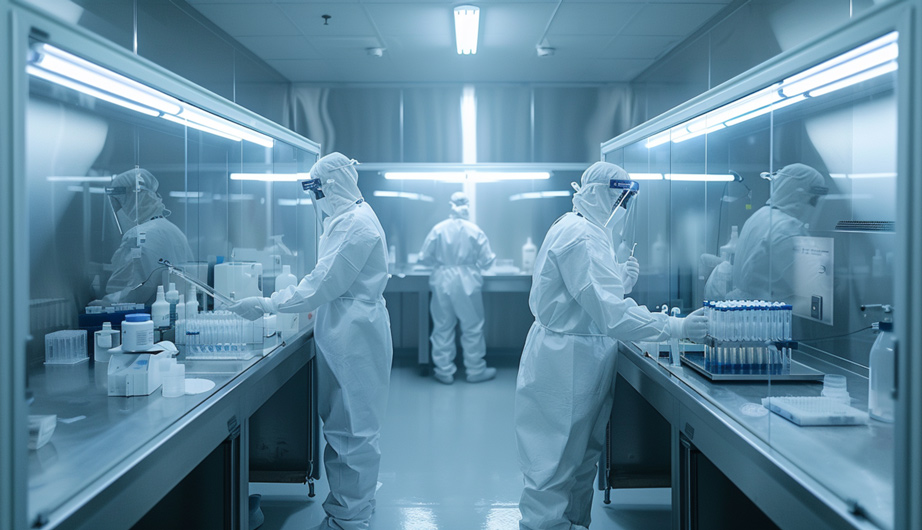
Protocols for Cleanroom Personnel
Required Training and Protocols
Personnel working in cleanrooms undergo rigorous training to adhere to strict protocols that maintain the integrity of the controlled environment. This training encompasses understanding the principles of contamination control, proper use of cleanroom technology, and adherence to standard operating procedures (SOPs).
Gowning Procedures to Prevent Contamination
Gowning procedures are a critical component of cleanroom protocols. Personnel must don specialized apparel, which typically includes coveralls, hoods, gloves, booties, and face masks. This attire is designed to minimize the shedding of skin flakes, fibers, and other contaminants that could compromise the cleanroom’s sterile environment.
Challenges Faced by Cleanroom Personnel
Cleanroom personnel must navigate challenges such as adhering to meticulous gowning procedures, avoiding behaviors that could introduce contaminants, and remaining vigilant about personal hygiene. The repetitive nature of these protocols requires a high level of discipline and attention to detail.
Continuous Training and Protocol Adherence
Ongoing training is essential for maintaining operational excellence in cleanroom environments. Regular refreshers and updates on SOPs ensure that personnel are current with the latest practices. At G-Con, we emphasize the importance of continuous education and strict adherence to protocols to ensure that our cleanrooms consistently meet the stringent requirements necessary for medical device manufacturing.
Technological Advancements in Cleanroom Equipment
The landscape of cleanroom technology is continually evolving, with new advancements enhancing the precision and efficiency of medical device manufacturing. At G-Con, we stay at the forefront of these innovations, ensuring that our cleanroom solutions leverage the latest advancements for your benefit.
Automation and Robotics in Cleanrooms
Automation and robotics have become integral to modern cleanrooms, performing tasks with a level of precision and consistency unmatched by manual operations. These technologies minimize human intervention, thereby reducing the risk of contamination and increasing throughput.
Equipment’s Role in Maintaining Standards
The equipment within a cleanroom is critical for maintaining the required standards. From particulate filtration systems to sterilization units, each piece plays a role in ensuring the environment stays within the specified ISO class parameters. Regular calibration and maintenance of this equipment are essential for uninterrupted cleanroom operation.
G-Con’s Integration of Advanced Technologies
Our team at G-Con specializes in integrating these advanced technologies into cleanroom designs. We understand that each medical device manufacturing process has unique requirements, and we tailor our solutions accordingly. By partnering with us, you’re ensuring that your cleanroom is equipped with cutting-edge technology that meets the stringent demands of the medical device industry.
Monitoring and Validation in Cleanroom Environments
Ensuring that cleanrooms meet the stringent standards required for medical device manufacturing involves rigorous monitoring and validation processes. At G-Con, we prioritize these practices to maintain the highest levels of compliance.
Methods for Monitoring Cleanroom Conditions
- Environmental Monitoring: Continuous monitoring of particulate levels, temperature, humidity, and pressure is conducted using advanced sensors and data logging systems.
- Particle Counting: Regular particle counting is performed to measure the concentration of airborne particles, ensuring they remain within the limits set by the ISO classification.
- Microbial Monitoring: Air and surface samples are collected to detect any microbial contamination, which is critical for maintaining aseptic conditions.
Validation Frequency for Compliance Assurance
Cleanrooms should be validated at intervals defined by industry standards and regulatory guidelines. This typically includes:
- Initial Validation: Conducted upon installation and before the cleanroom is operational.
- Periodic Revalidation: Scheduled at regular intervals, often annually, to ensure ongoing compliance.
- Post-Maintenance Validation: Performed after any significant repairs, upgrades, or changes to the cleanroom structure or systems.
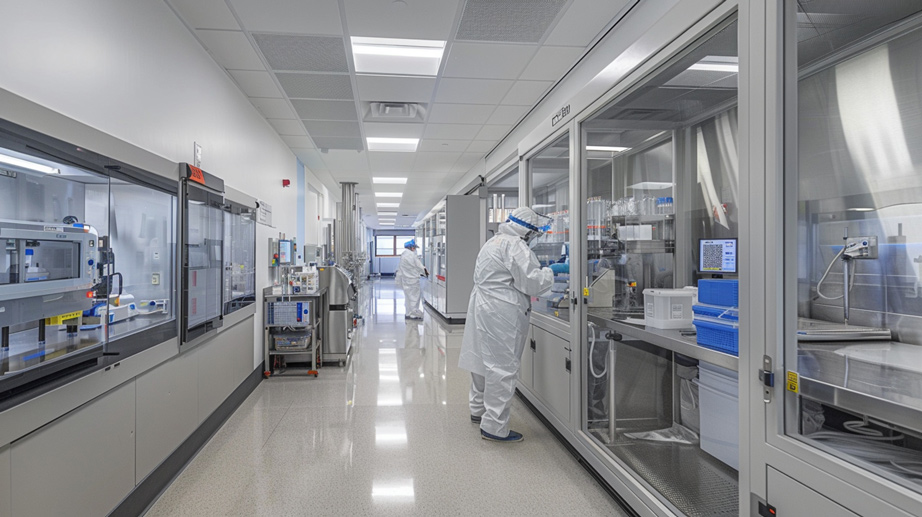
Challenges in Cleanroom Validation and Compliance
Common challenges include adapting to changes in regulatory standards, managing the complexity of integrated systems, and ensuring that all personnel are trained on the latest protocols.
Role of Continuous Monitoring
Continuous monitoring plays a vital role in maintaining cleanroom standards by providing real-time data that can be used to make immediate adjustments to the environment. This proactive approach helps prevent deviations from the required conditions and supports a state of constant compliance.
By adhering to these stringent monitoring and validation practices, we ensure that your cleanroom environment is always compliant, supporting the production of safe and effective medical devices.
Materials and Supplies Management in Cleanrooms
Selecting the appropriate materials and supplies for use in cleanrooms is a critical aspect of maintaining a contamination-free environment. At G-Con, we understand that every material introduced into a cleanroom has the potential to impact the sterile conditions necessary for medical device manufacturing.
Safe Materials for Cleanroom Use
Materials deemed safe for cleanroom use are those that have low particulate shedding and are non-reactive with the cleanroom’s environment. These include:
- Cleanroom Wipes and Swabs: Made from materials that do not generate lint or particles.
- Cleanroom Apparel: Specially designed garments that trap contaminants released by the body.
- Cleaning Solutions: Solutions that are non-volatile and do not leave residues that could attract contaminants.
Preventing Contamination Through Proper Management
To prevent contamination, materials and supplies should be:
- Stored Appropriately: In designated areas that are as clean as or cleaner than the cleanroom itself.
- Handled with Care: Using proper techniques to minimize contact and reduce the risk of contamination.
- Regularly Inspected: For integrity and cleanliness before being brought into the cleanroom.
Challenges in Procurement and Storage
Challenges in procuring and storing cleanroom materials include ensuring supplier quality, managing inventory to prevent overstocking, and maintaining the cleanliness of storage areas.
Streamlining Management with Modular Solutions
Our modular cleanroom solutions facilitate efficient materials and supplies management by providing:
- Customizable Storage Areas: Designed to maintain the required cleanliness levels.
- Integrated Inventory Management Systems: To track and control stock levels.
- Adaptable Spaces: That can be reconfigured as your needs change, ensuring that the management of materials and supplies remains optimal.
By focusing on these key areas, we help you maintain the stringent control required over materials and supplies in your cleanroom, supporting the high standards necessary for medical device manufacturing.
Cost Management in Cleanroom Operations
Effective cost management is essential for the sustainability of cleanroom operations in medical device manufacturing. Understanding the key cost factors, such as initial setup, ongoing maintenance, and personnel training, is crucial for budgeting and financial planning.
Key Cost Factors
- Initial Setup: The investment in constructing a cleanroom can be significant, with costs varying based on size, complexity, and ISO classification requirements.
- Maintenance: Regular cleaning, equipment servicing, and re-certification contribute to the operational costs.
- Personnel: Training and equipping staff with the necessary skills and attire represent recurring expenses.
Optimizing Operations to Reduce Costs
Optimizing cleanroom operations involves streamlining processes, automating where possible, and implementing energy-efficient practices. These measures can lead to significant cost savings over time without compromising the quality of the cleanroom environment or the medical devices produced.
Balancing Cost and Compliance
Balancing the cost of cleanroom operations with the need to comply with stringent regulatory standards presents a challenge. It requires a strategic approach to resource allocation, ensuring that compliance is never compromised for the sake of cost savings.
Modular Cleanrooms as a Cost-Effective Solution
Modular cleanrooms, like those offered by G-Con, provide a cost-effective solution for medical device manufacturers. They are designed for quick installation, scalability, and flexibility, allowing for future expansion or reconfiguration without the need for extensive downtime or additional construction costs. Our modular solutions are tailored to meet your specific needs, ensuring compliance with industry standards while keeping an eye on cost-effectiveness.
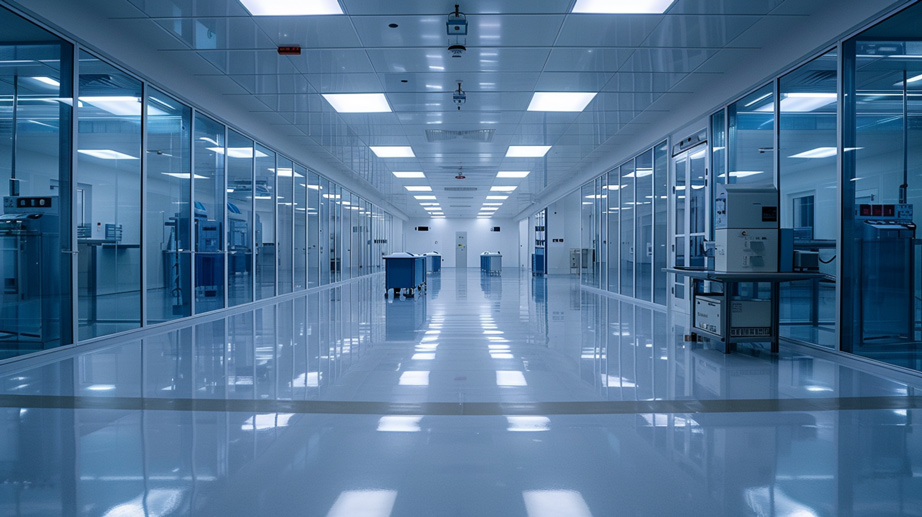
Optimizing Cleanroom Design for Environmental Sustainability
Incorporating environmental sustainability into cleanroom design is a commitment we at G-Con take seriously. Our approach to sustainable cleanroom construction involves the use of materials and processes that minimize environmental impact while maintaining compliance with industry standards.
Challenges in Sustainable Cleanroom Design
Creating environmentally sustainable cleanrooms presents challenges such as:
- Material Selection: Choosing materials that are both low in particulate shedding and have a reduced environmental footprint.
- Energy Efficiency: Designing systems that consume less energy, particularly in HVAC and lighting, without compromising the cleanroom’s performance.
- Waste Reduction: Implementing strategies to reduce waste during construction and operation.
Impact of Sustainable Practices
Sustainable practices in cleanroom design can lead to:
- Reduced Operational Costs: Energy-efficient designs can lower utility costs over the cleanroom’s lifecycle.
- Enhanced Corporate Responsibility: Demonstrating a commitment to sustainability can strengthen your brand and corporate image.
G-Con’s Contribution to Sustainability
At G-Con, we contribute to sustainability in cleanroom design by:
- Modular Construction: Our prefabricated cleanrooms reduce waste and allow for recycling of components.
- Energy-Efficient Solutions: We incorporate features such as LED lighting and energy recovery systems to reduce the environmental impact.
- Customization: Our cleanrooms are designed to adapt to your specific processes, ensuring efficient use of resources.
By choosing G-Con for your cleanroom needs, you’re selecting a partner that values sustainability as much as you do, ensuring that your operations are not only compliant but also environmentally responsible.
Emerging Trends in Cleanroom Technology
The landscape of cleanroom technology is rapidly evolving, with new advancements poised to enhance the efficiency and effectiveness of medical device manufacturing. As a leader in providing prefabricated cleanroom solutions, we at G-Con are committed to staying abreast of these developments to offer you the most advanced options available.
Impact of Technological Advancements on Cleanroom Design
Emerging technologies such as advanced air filtration systems, automation, and real-time environmental monitoring are set to revolutionize cleanroom design and operation. These innovations promise to deliver greater precision in contamination control and streamline cleanroom management, ensuring that the stringent standards for medical device manufacturing are consistently met.
Challenges in Adopting New Technologies
Adopting new cleanroom technologies can present challenges, including integration with existing systems, training personnel on new protocols, and managing the financial investment. However, the long-term benefits of improved quality control and operational efficiency can outweigh these initial hurdles.
Staying Ahead in Cleanroom Operations
To stay ahead of the curve, manufacturers should:
- Invest in Continuous Learning: Keeping teams informed about the latest cleanroom technologies and practices.
- Partner with Experts: Collaborating with cleanroom solution providers like G-Con that specialize in cutting-edge design and construction.
- Embrace Innovation: Being open to implementing new technologies that can drive improvements in cleanroom performance.
By focusing on these areas, you can ensure that your cleanroom operations are well-positioned to adapt to the future trends and maintain a competitive edge in the medical device manufacturing industry.
Tailored Modular Cleanroom Solutions from G-Con
At G-Con, we understand that each medical device manufacturing process has unique requirements. Our modular cleanroom solutions are designed to meet these specific needs, ensuring that your cleanroom environment aligns perfectly with your operational goals and compliance standards.
Unique Approach to Cleanroom Design
Our approach to cleanroom design is centered around flexibility and adaptability. We offer:
- Customizable Configurations: Our cleanrooms can be tailored to fit the spatial and environmental conditions of your facility.
- Scalability: As your business grows, our cleanrooms can expand with you, ensuring a seamless transition during scale-up processes.
- Rapid Deployment: Prefabricated and pre-tested, our cleanrooms are ready for quick installation, minimizing downtime and accelerating your time to market.
Getting Started with G-Con
To begin with our modular cleanroom solutions, you can:
- Contact Us: Reach out to our team to discuss your specific cleanroom needs.
- Consultation: We’ll provide a comprehensive consultation to understand your requirements and propose a tailored solution.
- Design and Manufacture: Our experts will design and manufacture a cleanroom that meets your specifications and industry standards.
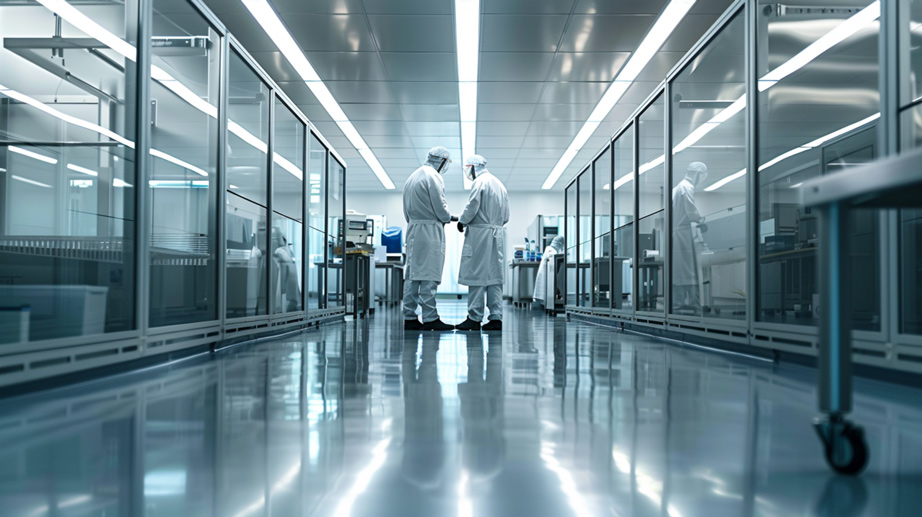
Why Choose G-Con
Choosing G-Con as your cleanroom design and manufacturing partner means selecting a team committed to quality, innovation, and customer satisfaction. Our turnkey solutions, backed by our ISO 9001:2015 certification, ensure that you receive a product that is not only compliant but also sets the standard for excellence in cleanroom environments.
For more information or to start a conversation about your cleanroom needs, please contact us at 979-431-0700. Our team is ready to provide you with the expertise and support necessary to make your project a success.